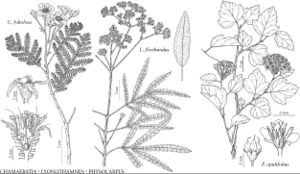Chamaebatia
Pl. Hartw., 308. 1849.
| Taxon | Illustrator ⠉ | |
|---|---|---|
 | Chamaebatia foliolosa Lyonothamnus floribundus Physocarpus opulifolius | Marjorie C. Leggitt Marjorie C. Leggitt Marjorie C. Leggitt |
Shrubs, 1–12 (–20) dm, herbage strongly aromatic. Stems 3–20+, sparsely branched; bark gray or reddish-brown, smooth; long-shoots present. Leaves persistent, 2–3-odd-pinnately compound; stipules persistent 1st year, deciduous with leaf base 2d year, linear-subulate, margins entire, sometimes stipitate-glandular; petiole present; blade obovate to obtrullate or lance-elliptic in outline, (2.8–) 3.5–7 (–9.4) cm, leathery, surfaces hirtellous; pinnae 8–17 per side, oblong to oblong-obovate, pinnately or 2-pinnately divided; ultimate segments oblong-obovate to obovate or obliquely obovoid, margins entire. Inflorescences terminal, (1–) 2–7 (–10) -flowered, corymbs or panicles; bracts present; bracteoles present. Pedicels present. Flowers 10–19 mm diam.; hypanthium funnelform-turbinate, 3–6 mm diam., exterior hairy, usually stipitate-glandular; sepals 5, reflexed, deltate; petals 5, caducous, white, orbiculate, base short-clawed, margins erose-undulate, apex often retuse; stamens 35–65 (–76), shorter than petals; torus absent; carpels 1 (or 2), sessile, stigmas lateral. Fruits achenes, 1, subglobose, 3–5.5 mm, smooth; hypanthium persistent; sepals persistent, erect. x = 9.
Distribution
Calif., nw Mexico
Discussion
Species 2 (2 in the flora).
Molecular data support inclusion of Chamaebatia with Cercocarpus, Dryas, and Purshia in subfam. Dryadoideae. Chamaebatia differs from the other genera in its sessile carpels and smooth, rounded fruit wall with a mesocarp of macrosclereids. Vegetative and floral similarities to Chamaebatiaria (subfam. Amygdaloideae) are perplexing.
Selected References
None.
Lower Taxa
Key
| 1 | Leaf blades obovate to obtrullate, 3-pinnately compound; terminal leaflet lobes each with terminal short-stipitate gland. | Chamaebatia foliolosa |
| 1 | Leaf blades lance-elliptic, 2–3-pinnately compound; terminal leaf lobes each with terminal sessile or embedded gland. | Chamaebatia australis |
"thin" is not a number."dm" is not declared as a valid unit of measurement for this property.